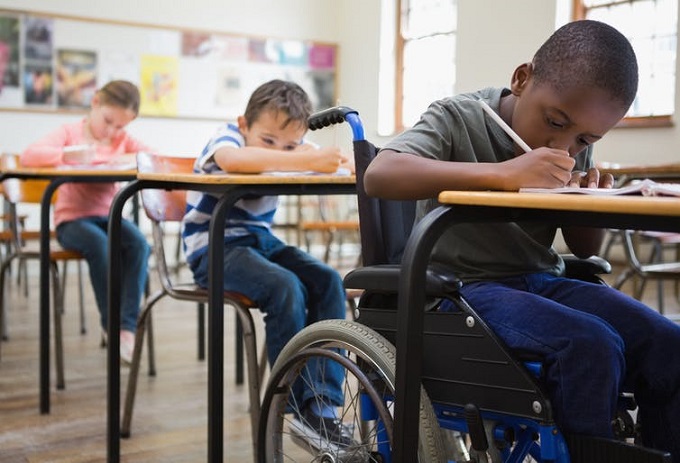
Just yesterday morning, I was arguing that school funding was at an impasse. By early afternoon that had all changed, along with the federal government’s rhetoric on school funding. Instead, we were introduced to Gonski 2.0.
For the first time, Education Minister Simon Birmingham has proposed a credible plan to deliver needs-based funding.
But is this the plan we have been looking for?
Where we were at, before the announcement
The Gonksi report in 2011 was an inspired attempt to move past decades of funding wars.
Negotiated or bastardised (depending on your point of view) in its implementation by the last Labor government, it was at first derided, then supported, then buried by the Coalition under Tony Abbott.
The re-boot of leadership under Malcolm Turnbull left school funding in limbo. The resulting policy vacuum led to a messy and unfocused debate.
Labor continued to claim that the only true path was to add billions of dollars to school funding. But Labor’s figures are greatly inflated because of its unwillingness to make tough decisions – or recognise the benefits of historically low wages growth.
At one point, Turnbull suggested to the Council of Australian Governments (COAG) that funding should be split, with the Commonwealth paying for non-government schools and states paying for government schools. But this is a terrible idea with big risks and few benefits.
Birmingham then publicly supported needs-based funding, but could not explain how we would get there.
Grattan Institute published our own plan last November, arguing that the Coalition could deliver Gonski-style needs-based funding without more money, if it made some tough decisions about indexation and over-funded schools.
[pro_ad_display_adzone id=”5852″ align=”left” padding=”3″]What has now changed?
Flanked by the big-Gonski himself, Turnbull and Birmingham finally announced the Coalition’s plan.
1) They recommitted to the principles of Gonski, which they referred to as genuine needs-based funding and branded as Gonski 2.0.
2) They promised not to tinker with the overall design of the funding formula for each school, called the “Schooling Resource Standard” or SRS. (The details of the SRS formula should be reviewed, since there are flaws and the original analysis was done with too little evidence. But the formula follows the core design suggested by Gonski, and makes sense.)
3) They disentangled Commonwealth and state funding, arguing that Commonwealth funding should depend on need, not on where students live.
So now, for the first time, the Commonwealth will have a simple and transparent way to explain how it funds schools:
-
Every school has a target level of funding, the SRS
-
Government schools receive Commonwealth funding equal to 20% of SRS (up from 17% on average today)
-
Non-government schools receive Commonwealth funding equal to 80% of SRS (up from 77%).
This is a big change from the current model, under which comparable students in similar schools could receive thousands of dollars more or less from the Commonwealth depending on which state or territory they live in.
States and territories will be expected to maintain their real level of funding, but will not otherwise be tied to the SRS formula.
This gives states some flexibility in how much they invest in schools, a good idea in a federal system.
So far so good. But for the numbers to add up, five more changes were needed.
4) Turnbull and Birmingham reduced the long-term indexation rate so that school funding will grow in line with a blend of wages and CPI after 2021.
This change will save billions of dollars over the long term compared to the current legislation.
5) They extended the timeline out to 10 years, giving the power of compound interest more time to do its magic.
6) They tweaked some of the special deals Julia Gillard struck with the Catholic school system. These tweaks will have the effect of expecting parents to contribute more, especially in Catholic primary schools.
7) They finally overturned the mantra of “no school will lose a dollar”, thereby saving maybe $1.5 billion over the next decade.
8) They added new money to the pot compared to the 2016 budget – $2.2 billion over the next four years, substantially more over the long term.
Who are the big winners and losers?
Compared to the Labor proposal, most schools, sectors and states will feel like losers. But taxpayers are big winners.
Grattan’s analysis shows that Labor’s plan is far more expensive than required, a huge problem given the state of the federal budget.
Compared to the 2016 budget, the big winners are:
-
Government schools in states that are currently underfunded, especially New South Wales, Victoria and Queensland
-
Western Australia, which receives much less from the Commonwealth for its government schools
-
Underfunded independent schools (especially the lower-fee schools, some of which are the most underfunded schools in the entire country).
Compared to the 2016 budget, the big losers are:
-
Catholic schools, which will lose a number of special deals (especially for the Australian Capital Territory which had a special deal all of its own); more analysis is needed to understand whether they will be worse off overall
-
24 highly over-funded schools that will have their per-student funding cut
-
About 300 slightly over-funded schools that will have their funding slowed or frozen. It is not entirely clear who these schools are at this stage.
Where does this all leave us?
We can now move on from the phoney war to a genuine debate about a concrete and credible proposal. Three things should happen now.
First, there will need to be much broader consultation than has occurred so far. The multitude of states, sectors and other stakeholders in schooling will need to mollified, even if some will never be fully satisfied.
Second, the federal government needs to pass legislation to give effect to the new funding arrangements. This is a big task: timing is tight, given the current deal runs out before the start of the 2018 school year. The senate will be a challenge.
Third, Gonski himself will lead an expert review, to report by the end of this year. His task is to synthesise the evidence on what works and provide advice on how the extra funding should be spent.
Many shots are still to be fired. But this clear, positive approach could be just what we need to get us past the squabbling on funding – a key hurdle so that we can move on to the issues that will really drive improvements in school education.
If that happens, everyone will be a winner, especially Australia’s students.
Well, maybe not everyone. If Gonski 2.0 sticks, the Labor party will need to find a new signature issue to take to the next election.
![]() This piece was written by Peter Goss, School Education Program Director, Grattan Institute. The article was originally published on The Conversation.
This piece was written by Peter Goss, School Education Program Director, Grattan Institute. The article was originally published on The Conversation.
• This piece was amended on 3 May to correct a point that was made. The piece suggested that the 300+ schools that will have their funding cut will “probably include government schools in the ACT that are currently funded well above target”. However it is not yet clear who these schools are. The sentence has been amended to reflect this.







